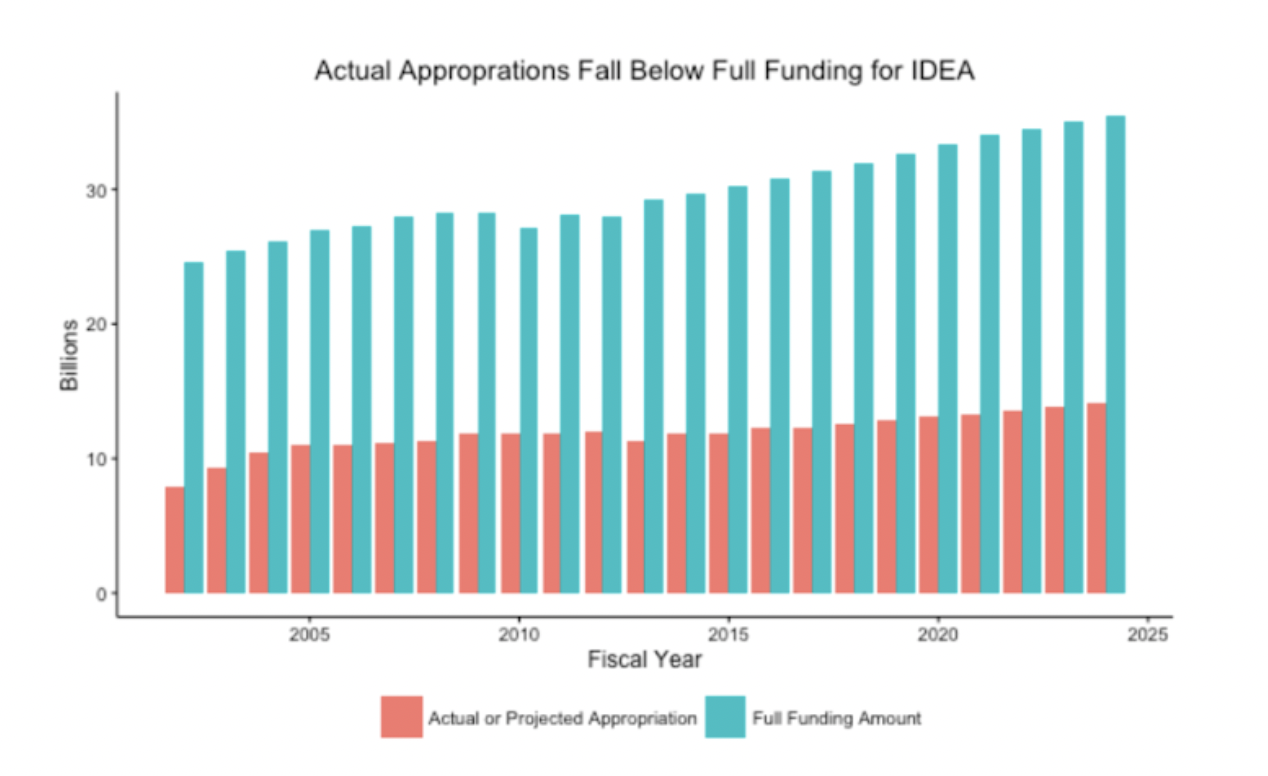Title: Increasing School and Early Intervention Services
Executive summary
Occupational therapy (OT) services within schools and early intervention are crucial for children to obtain the necessary education to be successful. Although studies have shown that students involved in special education need services, the quality of services is lacking within the schools when comparing the outcomes of students with disabilities to peers (Barry University, 2021). The Individuals with Disabilities Act (IDEA) was established to require that institutions offer accessible, equal, inclusive, and free education to all students and be delivered in the least restrictive environment (National Council on Disability, 2018).
Each school receives various amounts of funding, which may affect the quality and quantity of services provided (Barry University, 2021). When IDEA was first established, promises were made by the federal government to pay 40% of the average cost to educate a student (National Council on Disability, 2018). However, that promise has never been met, leaving all schools and institutions to find the financial resources required to meet the IDEA obligations that have been set. Other problems occurring due to the lack of funding include limited resources within the institutions, limited faculty and professionals for students with disabilities, and restricted hours due to the school system (National Council on Disability, 2018).
Context and scope of the problem
OT services are the third most utilized service in school systems. However, many educational systems still limit the scope of what services can be provided and the criteria to receive such services (American Occupational Therapy Association, 2022). It has been reported that therapists in school systems “spend 25-35 percent of their time on medicaid paperwork”, rather than time spent with students who would benefit from occupational therapy interventions (National Council on Disability, 2018). This indicates that school-based occupational therapists are not appropriately utilized, and therefore, insufficient children are receiving services. Additionally, in California, only 13% of students receiving additional services passed the state's math standards exam in 2018-2019, compared to 43% of students who did not receive additional services (Barry University, 2021). These striking statistics demonstrate a need for increased OT services in school systems, so that schools across the country can devote adequate time and resources towards their students.
Policy alternatives
A current federal government requirement is to spend 15% of IDEA on educating students with no disabilities (National Council on Disability, 2018). While the promise of the federal government covering 40% of education costs is not being met, this demand to spend 15% on students without disabilities only takes away from this disadvantaged population further. IDEA 2004 states that more learning time, new instructional approaches, better-trained teachers, collaborative teaching, and more support services are needed to help these students with disabilities learn the appropriate curriculum (IDEA, 2004). To provide this support, 15% of IDEA should be redirected to help the students with additional needs.
Another current policy approach created to increase funding is the “Funding Early Childhood is the Right IDEA Act”. Congressman Mark DeSaulnier and Congressman Rodney Davis introduced this act in 2019, expecting increased funding over the next four years for young students needing special education services (California School Boards Association, 2019). This act can be considered a step in the right direction to relocate funds to the allocated places where they were promised to be.
Policy recommendations
IDEA supports children requiring occupational therapy services and should be receiving the education and intervention services students need to perform with peers and gain functional skills. However, the services have been limited due to insufficient funding, decreasing service providers and personnel to offer services, restricted servicing hours in school systems, and the reduction or elimination of other necessary general programs (National Council on Disability, 2018). In March of 2020, the Education Stabilization Fund (ESF) was implemented to provide further funding for schools in general and special education services during the COVID-19 pandemic. Although no funding was provided to state agencies to administer early intervention services (American Occupational Therapy Association, 2021). A gap remains in the funding and support for school and early intervention services.
The following can help to gain support for governmental regulations on increasing school and early intervention services:
OTs and OTAs support AOTA in bringing attention to the issue and urging Congress to fund IDEA across states (Saffer, 2021) fully equitably.
OTs in school and early intervention settings educate other necessary faculty on the importance of integrating general and special education students in less restrictive environments (Barry University, 2021).
Demonstrate the benefit of OT in school settings to inform both state and federal elected officials to allow OTs and OTAs to perform their full scope of practice (AOTA, 2022).
Advocate for the need for OT in school and early intervention services and educate on the purpose of the profession in these settings.
Appendices
Figure 1: IDEA Funding Per Fiscal Year (Dancy, 2016)
References
American Occupational Therapy Association. (2021). The American rescue plan includes a big win for IDEA; AOTA continues to seek full funding. Retrieved October 16, 2022, from https://www.aota.org/advocacy/advocacy-news/legislative-issues-update/american-rescue-plan-idea
American Occupational Therapy Association. (2022). AOTA federal efforts to support school-based practitioners, the GROW SISPs act and more. Retrieved October 15, 2022, from https://www.aota.org/advocacy/advocacy-news/2022/federal-efforts-supporting-school-based-practitioners
Barry University. (2021). Narrowing the gap in special education. Retrieved October 15, 2022, from https://online.barry.edu/degrees/education/masters-science/ese/narrowing-the-gap-in-sped/
California School Boards Association and Association of California School Administrators on Federal Bill to Increase Individuals With Disabilities Act Funding. (2019). Targeted News Service. https://link.gale.com/apps/doc/A595154282/STND?u=lirn55718&sid=ebsco&xid=227ec104
Dancy, K. (2016). Fully funding idea: A democratic dream or just an empty promise? New America. Retrieved October 16, 2022, from https://www.newamerica.org/education-policy/edcentral/fully-funding-idea/
Individuals with Disabilities Education Improvement Act of 2004, Pub. L. 108-446, 118 Stat. 2647 (December 3, 2004).
National Council on Disability. (2018). Broken promises: The underfunding of IDEA- IDEA series. Retrieved October 15, 2022, from https://eric.ed.gov/?id=ED588512
Saffer, A. (2021). Winning vital support for early intervention as part of the congressional America rescue plan. Retrieved October 16, 2022, from https://www.aota.org/publications/ot-practice/ot-practice-issues/2021/support-for-rescue-plan
